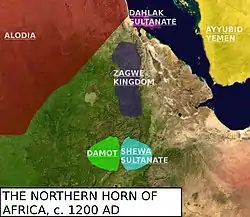Kingdom of Damot
The Kingdom of Damot (Amharic: ዳሞት) was a medieval kingdom in what is now western Ethiopia.[1] The territory was positioned below the Blue Nile.[2] It was a powerful state that forced the Sultanate of Showa (also called Shewa) to pay tributes. It also annihilated the armies of the Zagwe dynasty that were sent to subdue its territory. Damot conquered several Muslim and Christian territories.[3] The Muslim state Showa and the new Christian state under Yekuno Amlak formed an alliance to counter the influence of Damot in the region.[4]
Kingdom of Damot | |||||||
|---|---|---|---|---|---|---|---|
| 900–1317 | |||||||
 The kingdom of Damot and its neighbours circa 1200 AD | |||||||
| Capital | Damot 9.39°N 37.56°E | ||||||
| Common languages | Gonga, and other Omotic languages | ||||||
| Religion | Pagan | ||||||
| Government | Monarchy | ||||||
| Motalami | |||||||
| History | |||||||
• Established | 900 | ||||||
• Disestablished | 1317 | ||||||
| |||||||
History
Damot's history as an independent entity ended after the conquest of the region by Emperor Amda Seyon in the fourteenth century and remained under the Solomonic dynasty's influence afterwards.[5] Originally located south of the Abay and west of the Muger River,[6] under the pressure of Oromo attacks the rulers were forced to resettle north of the Abay in southern Gojjam between 1574 and 1606.[7]
The kings, who bore the title Motalami, resided in a town which, according to the hagiography of Tekle Haymanot, was called Maldarede.[8] The kingdom was reduced to smaller size and the name became the Kingdom of Wolayta . Their territory extended east beyond the Muger as far as the Jamma.[6] The province of Damot remained part of the Ethiopian Empire well after the Zemene Mesafint began, unlike other southern regions. The ruler of Damot was typically from Gojjam and held the title Ras.
References
- Shinn, David (2013). Historical Dictionary of Ethiopia. Scarecrow Press. p. 111. ISBN 9780810874572.
- Shillington, Kevin (4 July 2013). Encyclopedia of African History 3-Volume Set. Routledge. ISBN 9781135456696.
- Bounga, Ayda (2014). The kingdom of Damot: An Inquiry into Political and Economic Power in the Horn of Africa (13th c.). Annales D'ethiopie. p. 262.
- Hassen, Mohammed. Oromo of Ethiopia (PDF). University of London. p. 4.
- Quirin, James (1992). The evolution of the Ethiopian Jews: a history of the Beta Israel (Falasha) to 1920. University of Pennsylvania Press. p. 43. ISBN 9780812231168.
- G.W.B. Huntingford, Historical Geography of Ethiopia from the first century AD to 1704 (London: British Academy, 1989), p. 69
- The dates for this movement are discussed by Huntingford in his Historical Geography, at pp. 143f
- Bouanga 2014, pp. 33–37.
Further reading
- Bouanga, Ayda (2013). Le Damot dans l'histoire de l'Ethiopie (XIIIe-XXe siècles) : recompositions religieuses, politiques et historiographiques (in French). Université Panthéon-Sorbonn.
- Bouanga, Ayda (2014). "Le royaume du Damot : enquête sur une puissance politique et économique de la Corne de l'Afrique (XIIIe siècle)" (PDF). Annales d'Ethiopie (in French). 29: 27–58. doi:10.3406/ethio.2014.1557.